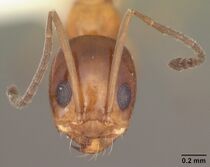Key to Dorymyrmex of SE United States workers
This worker key is based on: Trager, J.C. 1988. A revision of Conomyrma (Hymenoptera: Formicidae) from the southeastern United States, especially Florida, with keys to the species. Florida Entomologist 71: 11-29.
Please be aware this genus in the Nearctic is fraught with problems in delimiting and determining species. There is also a Key to the Nearctic Dorymyrmex (Snelling 1995).
You may also be interested in
1
- Mesonotal profile, in all or the great majority of workers of a series, either evenly convex (Figs. 9, 11), or flat to weakly concave (Fig. 10) . . . . . 2
- Mesonotal profile, in all or the great majority of workers of a series, angular, having distinct dorsal and declivous faces (Figs. 8, 12-14) . . . . . 4
2
return to couplet #1
- Promesonotal profile convex; base of propodeum at an angle of 145° or less to the plane of the posterior portion of the mesonotum (Figs. 9, 11), scape exceeding occipital margin by 1/3, or less, its length in frontal view (Figs. 2, 4); color variable . . . . . 3
- Thorax elongate, with promesonotal profile flattened and upward slope of base of prop ode urn at an angle of 165°, or more, to the plane of the mesonotal dorsum (Fig. 10); scape exceeding occipital margin by almost 112 its length (Fig. 3); color clear, weakly shining yellow, with at most a trace of darkening near gastric apex; a slender, long-legged form known only from the scrub and xeric woodlands of Highlands Co., Florida . . . . . Dorymyrmex elegans
3
return to couplet #2
- Head broad (Cl>87, less in minim workers); scape relatively short (SI <112); propodeal cone blunt, its posterior face straight or slightly convex (Fig. 9); color usually predominantly yellow, but if head and gaster extensively infuscated, thoracic dorsum also with at least faint brownish blotching; a common species in disturbed habitats, usually with sandy soils, from Mississippi to Maryland, especially abundant in Florida . . . . . Dorymyrmex bureni
- Head narrower (Cl <87); scape longer (Sl> 112, as low as 109 in about 5% of workers); propodeal cone sharper, appearing faintly recurved because posterior face of prop ode urn slightly concave (Fig. 11); head dark brown, thorax clear yellow (never with faint, dorsal blotching), gaster dull brown; a locally abundant species in sand pine scrubland of central Florida . . . . . Dorymyrmex flavopectus
4
return to couplet #1
- Gaster densely pubescent, pubescence closely spaced and at least partly obscuring sheen of gastric dorsum; angle between dorsal and declivous mesonotal faces broadly obtuse (≥ 140°); mesonotal declevity not unusually steep (Fig. 12, 14) . . . . . 5
- Gaster lacking pubescence, or at most with a few widely spaced, fine setae which do not obscure the sheen of the gastric dorsum; mesonotum more acutely angular, angle between dorsal and declivous mesonotal faces 90°-120°, mesonotal declivity steep (Fig. 8); a common but inconspicuous species of turkey oak savannas and oak scrubland in Florida and adjacent Georgia . . . . . Dorymyrmex bossutus
5
return to couplet #4
- Head broad (CI>90); occipital border normally distinctly concave; propodeal cone large and prominent (Fig. 13, 14); larger species (HTL> 1.95) . . . . . 6
- Head narrower (CI <88, rarely up to 90); occipital border weakly convex or straight; propodeal cone low and not as prominent (compare Figs. 12 and 13); smaller species (HTL<1.95); a species of openings in well-drained pine-oak woodland from northern Florida to New Jersey . . . . . Dorymyrmex grandulus
6
return to couplet #5
- Scape relatively long (SI 98-111, but > 101 in 80% of workers measured); pubescence dense but very short, absent on sides of head; sides of head very shiny; front of head and dorsum of thorax only slightly dulled by pubescence; head and thorax, and often base of first tergite reddish; gaster dark brown; found within or near populations of D. bureni or D. bossutus; colonies small, inhabiting one or a few nests; queen small, HTL < 3 mm . . . . . Dorymyrmex reginicula
- Scape short (SI 95-105, but < 101 in over 80% of workers measured); pubescence dense, dulling front of head and thoracic dorsum; uniform brown to black; also found within or near populations of D. bureni in the Southeast, sometimes in huge polycalic colonies; queens larger, HTL > 3.25 mm . . . . . Dorymyrmex medeis (=Dorymyrmex smithi)














